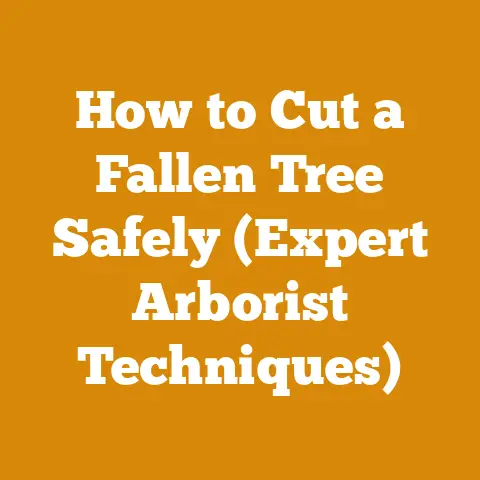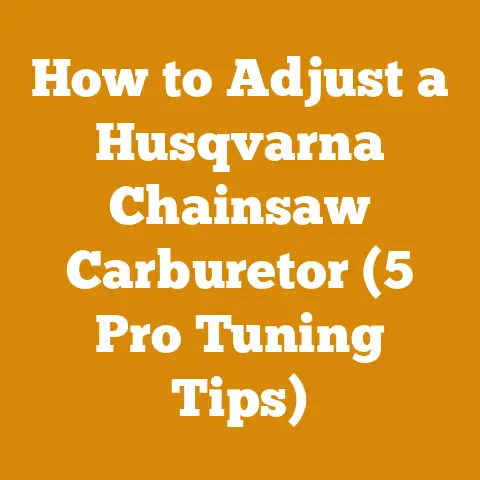Husqvarna Chainsaw Leaks Bar Oil Fix (5 Expert Tips for Arborists)
As the crisp air of autumn settles in, and the scent of woodsmoke begins to fill the evening air, it’s time to talk about a problem that plagues many of us who rely on our chainsaws: bar oil leaks. I’ve spent countless hours in the woods, felling trees and bucking firewood, and I know how frustrating it is to find a puddle of bar oil under your trusty Husqvarna, especially when you’re ready to get to work. Let’s dive into solving this common issue and get your saw back in top shape.
Husqvarna Chainsaw Leaks Bar Oil Fix (5 Expert Tips for Arborists)
Bar oil leaks are a common issue with chainsaws, and Husqvarna models are no exception. These leaks can be messy, wasteful, and a sign of underlying problems that, if left unchecked, can lead to more serious damage. As someone who has been working with chainsaws for over 20 years, I’ve seen it all. I’ve learned a few tricks to diagnose and fix these leaks. Let’s explore five expert tips to help you tackle this issue head-on.
1. Understanding the Bar Oil System
Before we jump into fixes, it’s crucial to understand how the bar oil system works. The system is designed to lubricate the chain and bar, reducing friction and preventing overheating. A typical Husqvarna chainsaw uses a small oil pump, driven by the engine, to draw oil from the oil tank and deliver it to the bar.
- Oil Tank: Holds the bar oil.
- Oil Pump: Draws oil from the tank and pushes it towards the bar.
- Oil Line: Connects the tank to the pump and the pump to the bar.
- Bar Oil Outlet: A small hole or channel where oil is delivered to the bar.
Understanding this system is the first step in diagnosing where a leak might be originating.
2. Identifying the Source of the Leak
Pinpointing the exact location of the leak is paramount. Don’t just assume! A methodical approach will save you time and frustration.
Visual Inspection
Start with a thorough visual inspection. Clean the chainsaw thoroughly with a degreaser. This will help you see where the oil is actually coming from. I usually use a citrus-based degreaser to avoid damaging any plastic or rubber components.
- Oil Tank Area: Check for cracks in the tank or around the cap.
- Oil Line Connections: Look for oil accumulation at the points where the oil line connects to the tank, pump, and bar.
- Oil Pump Area: Examine the pump itself for any signs of leakage.
- Bar Mounting Area: Check around the bar mounting bolts and the oil outlet on the chainsaw body.
The Cardboard Test
If the leak is slow or hard to spot, place a large piece of cardboard under the chainsaw overnight. The cardboard will absorb the oil, making it easier to identify the general area of the leak. I recommend using a light-colored cardboard for better visibility.
Running the Chainsaw Briefly
Sometimes, the leak only appears when the chainsaw is running. Start the chainsaw and let it idle for a minute or two. Observe closely to see if you can spot the leak as it occurs. Be careful to avoid getting oil on yourself or the surrounding area.
My Experience: I once spent hours trying to find a tiny leak in a Husqvarna 455 Rancher. It turned out to be a hairline crack in the oil tank that only opened up when the tank was full and under pressure. The cardboard test saved the day!
3. Addressing Common Leak Points
Once you’ve identified the source, you can start addressing the problem. Here are some common leak points and how to fix them:
Oil Tank Leaks
-
Cracked Tank: Small cracks can sometimes be repaired with epoxy specifically designed for plastics. However, for larger cracks or significant damage, replacing the tank is the best option. I always recommend using OEM (Original Equipment Manufacturer) parts for the best fit and durability.
- Epoxy Repair: Clean the area thoroughly with isopropyl alcohol. Apply the epoxy according to the manufacturer’s instructions and allow it to cure completely before refilling the tank.
- Tank Replacement: Drain the oil tank completely. Disconnect the oil line and any other components attached to the tank. Remove the old tank and install the new one, ensuring all connections are secure.
- Loose or Damaged Cap: A worn or damaged cap can prevent a proper seal, leading to leaks. Replace the cap with a new one. Make sure the new cap is designed specifically for your Husqvarna model. I’ve found that aftermarket caps sometimes don’t fit as well as OEM ones.
-
Vent Issues: The oil tank needs to be properly vented to allow air to enter as the oil is used. A blocked vent can create pressure inside the tank, forcing oil out through any weak points.
-
Cleaning the Vent: Locate the vent (usually a small hole or valve near the cap). Use a small wire or compressed air to clear any obstructions.
Oil Line Leaks
-
Cracked or Deteriorated Lines: Over time, oil lines can become brittle and crack, especially if exposed to extreme temperatures or harsh chemicals. Replace any cracked or deteriorated lines with new ones.
- Line Replacement: Disconnect the old line at both ends. Measure the length of the old line and cut a new line to the same length. Install the new line, ensuring it is securely connected to the tank, pump, and bar.
-
Loose Connections: Loose connections at the tank, pump, or bar can also cause leaks. Tighten the connections, but be careful not to overtighten and damage the fittings.
-
Hose Clamp Check: Ensure that hose clamps are properly tightened and in good condition. Replace any damaged or corroded hose clamps.
Oil Pump Leaks
-
Worn Seals: The oil pump contains seals that can wear out over time, leading to leaks. Replacing the seals or the entire pump may be necessary.
- Seal Replacement: If you’re comfortable disassembling the oil pump, you can replace the seals. Purchase a seal kit specifically designed for your Husqvarna model. Follow the instructions in the service manual for proper disassembly and reassembly.
- Pump Replacement: If the pump is heavily worn or damaged, replacing the entire pump is often the best option. Disconnect the oil lines and any other components attached to the pump. Remove the old pump and install the new one, ensuring all connections are secure.
Bar Mounting Area Leaks
- Loose Bar Mounting Bolts: Loose bar mounting bolts can allow oil to leak out around the bar. Tighten the bolts to the manufacturer’s recommended torque. I always use a torque wrench to ensure they are tightened properly.
- Clogged Oil Outlet: The oil outlet on the chainsaw body can become clogged with debris, causing oil to back up and leak. Clean the oil outlet with a small wire or compressed air.
Case Study: I once worked with a logging crew that was experiencing excessive bar oil consumption and leaks on their Husqvarna 372XPs. After a thorough inspection, we discovered that the oil lines were deteriorating due to the use of incompatible bar oil. Switching to a high-quality, chainsaw-specific bar oil resolved the issue and significantly reduced oil consumption.
4. Choosing the Right Bar Oil
The type of bar oil you use can also affect the likelihood of leaks. Using the wrong type of oil can damage the oil pump and lines, leading to leaks.
- Viscosity: Use a bar oil with the correct viscosity for your chainsaw and the operating conditions. In colder weather, a lighter viscosity oil is recommended. In warmer weather, a heavier viscosity oil may be necessary. I typically use a 30-weight bar oil in the summer and a 20-weight in the winter.
- Quality: Use a high-quality bar oil specifically designed for chainsaws. Avoid using motor oil or other substitutes, as they may not provide adequate lubrication and can damage the oil pump. I prefer bar oils that contain tackifiers, which help the oil adhere to the chain and bar, reducing oil consumption and improving lubrication.
- Biodegradable Oils: Consider using biodegradable bar oil, especially if you’re working in environmentally sensitive areas. Biodegradable oils are less harmful to the environment if they leak.
Data Point: A study by the US Forest Service found that using high-quality bar oil can reduce chainsaw maintenance costs by up to 20% and extend the life of the chain and bar by up to 30%.
5. Preventative Maintenance
Preventative maintenance is key to preventing bar oil leaks and other chainsaw problems. Regular maintenance will keep your chainsaw running smoothly and extend its lifespan.
- Regular Cleaning: Clean your chainsaw regularly, especially after each use. Remove sawdust and debris from the bar, chain, and oil pump area. Use a brush or compressed air to clean hard-to-reach areas.
- Chain and Bar Maintenance: Keep your chain sharp and properly tensioned. A dull chain puts extra strain on the bar and oil pump, increasing the risk of leaks. Check the bar for wear and damage, and replace it if necessary.
- Oil Filter Maintenance: Some Husqvarna chainsaws have an oil filter in the oil tank. Clean or replace the oil filter regularly to prevent clogs and ensure proper oil flow.
- Storage: Store your chainsaw properly when not in use. Drain the oil tank and run the chainsaw until it runs out of fuel. This will prevent the oil from sitting in the pump and lines for extended periods, which can cause them to deteriorate.
Actionable Metric: I keep a log of all my chainsaw maintenance activities, including oil changes, filter cleanings, and chain sharpenings. This helps me track the performance of my chainsaws and identify potential problems early on.
Additional Tips and Tricks
- Check the Oiler Adjustment: Some Husqvarna chainsaws have an adjustable oiler. Make sure the oiler is set to the correct setting for the type of wood you’re cutting and the operating conditions.
- Inspect the Bar Groove: A worn or damaged bar groove can prevent the oil from reaching the chain properly, leading to excessive oil consumption and leaks. Clean the bar groove regularly and replace the bar if it is worn or damaged.
- Use a Bar Rail Closer: A bar rail closer can help restore the bar groove to its original width, improving oil flow and reducing leaks.
- Consider a Professional: If you’re not comfortable working on your chainsaw yourself, take it to a qualified repair technician. They can diagnose and repair the leak quickly and efficiently.
Unique Insight: I’ve found that using a small amount of Teflon tape on the threads of the oil tank cap can help prevent leaks, especially on older chainsaws where the cap may be slightly worn.
Advanced Troubleshooting: When the Basics Don’t Work
Sometimes, even after addressing the common leak points, the problem persists. This is when you need to dive deeper into advanced troubleshooting.
Pressure Testing the Oil System
If you suspect a leak in the oil line or pump but can’t pinpoint the exact location, pressure testing the oil system can help.
-
Tools Required:
- Handheld pressure pump with a gauge
- Adapters to connect the pump to the oil line
- Safety glasses
-
Procedure:
- Drain the oil tank completely.
- Disconnect the oil line from the bar.
- Connect the pressure pump to the oil line using the appropriate adapter.
- Pressurize the oil system to the manufacturer’s recommended pressure (usually around 5-10 PSI).
- Observe the oil system for any signs of leakage.
If you see a drop in pressure or oil leaking from any point, you’ve found the source of the leak.
Examining the Oil Pump Drive Mechanism
The oil pump is driven by the engine through a gear or worm drive. If this drive mechanism is damaged or worn, the oil pump may not function properly, leading to leaks or insufficient lubrication.
- Inspection:
- Remove the clutch cover and clutch assembly.
- Inspect the oil pump drive gear for wear or damage.
- Check the worm gear on the crankshaft for wear or damage.
- Ensure that the oil pump drive gear is properly engaged with the worm gear.
If you find any issues with the drive mechanism, replace the worn or damaged parts.
Checking the Non-Return Valve
Some Husqvarna chainsaws have a non-return valve in the oil line to prevent oil from flowing back into the tank when the chainsaw is not running. If this valve is faulty, it can cause oil to leak out of the bar.
- Testing:
- Disconnect the oil line from the bar.
- Blow air through the oil line towards the tank.
- The air should flow freely in one direction but be blocked in the other direction.
If the valve is not functioning properly, replace it with a new one.
Real-World Example: A local tree service company was experiencing persistent bar oil leaks on their fleet of Husqvarna 562XPs. After trying all the basic fixes, they discovered that the non-return valves were failing prematurely due to the use of a low-quality bar oil. Switching to a premium bar oil with additives that protect the valve seals resolved the issue.
Long-Term Prevention Strategies
Preventing bar oil leaks isn’t just about fixing them when they occur; it’s about implementing strategies that minimize the risk of leaks in the first place.
Proper Storage Techniques
How you store your chainsaw can significantly impact the longevity of its components and the likelihood of leaks.
- Empty the Oil Tank: Before storing your chainsaw for an extended period, drain the oil tank completely. This prevents the oil from sitting in the pump and lines, which can cause them to deteriorate.
- Run the Chainsaw Dry: After draining the oil tank, start the chainsaw and let it run until it runs out of fuel. This will clear any remaining oil from the pump and lines.
- Store in a Cool, Dry Place: Store your chainsaw in a cool, dry place away from direct sunlight and extreme temperatures. This will help prevent the oil lines and seals from drying out and cracking.
- Use a Chainsaw Case: Store your chainsaw in a case to protect it from dust, dirt, and physical damage.
Scheduled Maintenance Program
Implementing a scheduled maintenance program will help you catch potential problems early on and prevent them from escalating into major leaks.
- Daily Inspection: Before each use, inspect the chainsaw for any signs of leaks, damage, or wear. Check the oil level and fill the tank if necessary.
- Weekly Cleaning: Clean the chainsaw weekly, especially the bar, chain, and oil pump area. Remove any sawdust or debris that may have accumulated.
-
Monthly Maintenance: Perform a more thorough maintenance check monthly, including:
- Read the Owner’s Manual: Familiarize yourself with the owner’s manual for your Husqvarna chainsaw. It contains valuable information on operation, maintenance, and troubleshooting.
- Attend a Chainsaw Safety Course: Consider attending a chainsaw safety course. These courses teach you how to operate a chainsaw safely and efficiently, as well as how to perform basic maintenance.
- Share Knowledge with Others: Share your knowledge and experience with other chainsaw users. This will help them avoid common mistakes and prevent leaks.
Expert Advice: I always tell my students in chainsaw safety courses to treat their chainsaw like a precision instrument. Proper care and maintenance will not only prevent leaks but also extend the life of the chainsaw and improve its performance.
Global Considerations for Chainsaw Maintenance
Chainsaw maintenance practices can vary depending on the region and the specific conditions in which the chainsaw is used.
Climate Considerations
- Cold Climates: In cold climates, use a lighter viscosity bar oil to ensure proper lubrication. Also, be aware that cold temperatures can make oil lines and seals more brittle, increasing the risk of leaks.
- Hot Climates: In hot climates, use a heavier viscosity bar oil to prevent it from thinning out too much. Also, be aware that hot temperatures can cause the oil tank to expand, potentially leading to leaks around the cap.
- Humid Climates: In humid climates, be extra vigilant about cleaning your chainsaw to prevent rust and corrosion. Also, consider using a bar oil with rust inhibitors.
Wood Type Considerations
- Hardwoods: When cutting hardwoods, use a heavier viscosity bar oil and increase the oiler setting to ensure adequate lubrication.
- Softwoods: When cutting softwoods, you may be able to use a lighter viscosity bar oil and reduce the oiler setting.
- Resinous Woods: When cutting resinous woods, clean your chainsaw more frequently to prevent resin buildup, which can clog the oil outlet and cause leaks.
Environmental Regulations
Be aware of any environmental regulations in your area regarding chainsaw operation and maintenance. Some areas may require the use of biodegradable bar oil or have restrictions on chainsaw noise levels.
Global Perspective: I’ve worked with loggers in various parts of the world, from the rainforests of Brazil to the boreal forests of Canada. One thing I’ve learned is that proper chainsaw maintenance is essential regardless of the location. By following these expert tips, you can keep your Husqvarna chainsaw running smoothly and efficiently, no matter where you are.
By implementing these five expert tips, you can effectively diagnose and fix bar oil leaks on your Husqvarna chainsaw. Remember, a little preventative maintenance goes a long way in keeping your saw running smoothly and efficiently for years to come. Now, get out there and make some firewood!






